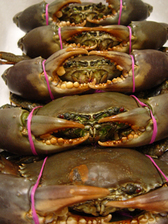 Original story by Dana Miller, University of British Columbia at The Conversation
Original story by Dana Miller, University of British Columbia at The Conversation

Skate, or “skate”?Photo: Andrew M Griffiths
The deliberate act of falsely representing, labelling or advertising food, known as “food fraud”, is not a recent phenomenon. The deceitful adulteration of food has a long history based on the promise of making a quick profit through dishonest customer transactions.
The uncovering of the widespread horse meat scandal across Europe indicates how pervasive, and often unnoticed, this problem can be. But it is difficult, if not impossible, to estimate just how widespread food fraud has been in the past or even at present, as it is hard to detect without resorting to relatively expensive DNA-based techniques.
An additional factor driving food fraud in the seafood industry is the pressure placed on certain commercially important fish species. Ocean-caught fish is the world’s last major wild food resource, but in the past 50 years, as industrialised fishing operations have become commonplace, overfishing has depleted our global supply of wild fish. Fisheries of some popular species have seen numbers reduced to low levels, at which point shortages provide an incentive to substitute a cheaper and more abundant species for a more desired species of fish.
There’s not only a potential human health issue from seafood mislabelling, but also a conservation problem: when one fish species is falsely labelled as another, consumers trying to avoid vulnerable or threatened species have their power to consume responsibly taken from them.
In recent years, multiple studies around the world have uncovered mislabelling involving many different varieties of seafood. Research I have worked on uncovered high levels of mislabelling in Western Europe of two commercially valuable whitefish, cod and haddock. More recently, working with a group of colleagues at the University of Salford in Britain, and University College Dublin in Ireland, we used DNA testing to identify the variety of species sold under the market name “ray”. In the process, we also unexpectedly found a small number of incorrectly labelled products on sale by a major UK supermarket.

A skate, before it has its wings clipped. Photo: Andy Martinez/NOAA
Ray is the common term under which a number of different species of skates fished from the Northeast Atlantic are commonly sold in Western Europe. Unlike the typically consumed bony fishes such as cod, haddock, hake and tuna, skates are a type of cartilaginous fish more closely related to sharks, which fall under the same subclass, Elasmobranchii.
The conservation status of skate varies by species so it’s difficult for consumers to make responsible decisions when purchasing fish labelled as “ray”. In our recently published study we found that a minimum of six different species are currently being sold under the term “ray”, three of which (blonde ray, thornback ray and shagreen ray) are included in the “near threatened” category within the IUCN Red List (which lists threatened species of plants and animals).
In the UK and Irish markets, very few products sold as “ray” came with any further description that identified the species. Although the use of common or umbrella terms in the labelling of seafood is currently legal within the EU, more descriptive labels that identify the species of fish being sold would make it easier for shoppers to make responsible decisions when purchasing fish.
What was concerning about this investigation was that, of the very few fish sold as “ray” that were packaged with detailed information to the species level, one third were found to be incorrectly labelled (two out of six samples). Though packaging indicated the fish were species of lower conservation concern, through DNA analysis, these products were identified as thornback ray, a near threatened species.
As the world’s human population grows and food production systems become larger and more mechanised, we are becoming increasingly separated from the original source of our food. Beyond trusting product labels, it’s difficult to have confidence in knowing what exactly we are eating and where it has originated from. Particularly in the seafood industry where species scarcity is of direct environmental concern, labels should contain adequate and accurate information that can enable consumers to make responsible choices if this is important to them.
To combat food fraud and in particular, the problem of seafood mislabelling, legislators need to improve labelling policy implementation and enforcement. Monitoring programs must include DNA-based species identification techniques, and punishments for fraudulent labelling must be adequate to act as a deterrent.
Dana Miller has received funding from the Irish Research Council for Science, Engineering and Technology (IRCSET), and from the Social Sciences and Humanities Research Council of Canada (SSHRC). She is currently affiliated with the Fisheries Economics Research Unit at the University of British Columbia.
 This article was originally published at The Conversation.
This article was originally published at The Conversation.
Read the original article.














